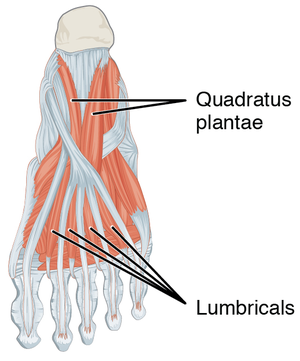Quadratus Plantae
Original Editor - Leana Louw
Top Contributors - Leana Louw, Patti Cavaleri and Kim Jackson
Description[edit | edit source]
Quadratus plantae makes part of the 20 individual foot muscles. It is situated in the second layer of muscles at the sole of the foot.[1] The muscle consists of a lateral and medial head, coming together to form the bulk of this muscle.[2]
Origin[edit | edit source]
Medial surface and lateral margin of the plantar surface of the calcaneus.[1]
Insertion[edit | edit source]
Posterolateral margin of tendon of flexor digitorum longus.[1]
Nerve[edit | edit source]
Lateral plantar nerve (S2, S3).[1]
Artery[edit | edit source]
Lateral plantar artery.[1]
Function[edit | edit source]
The muscles of the foot are arranged in compartments and layers, but function together to support the foot during stance phase and maintaining the arch of the foot. Quadratus plantae mainly functions by assisting flexor digitorum longus with flexion of the lateral 4 digits of the foot.[1]
Clinical Relevance[edit | edit source]
Quadratus plantae increase the stability of the foot during the stance phase of gait to resist toe extension. It is thus an important foot muscle to consider in the gait pattern and with gait retraining after foot injuries.
Related pathologies:[3]
- Calcaneus fractures: Can lead to contractures of quadratus plantae causing clawing of the 2nd to 5th toes.
- Diabetic foot: Untreated abscesses in the central plantar space can lead to necrosis of quadratus plantae.
- Heel pain: Can be the result of entrapment of the lateral plantar nerve between the two heads of quadratus plantae.
Assessment[edit | edit source]
- Palpation
- Gait assessment
Treatment[edit | edit source]
- Myofascial release[3]
- Trigger point therapy[3]
- Dry needling
- Gait training[4]
- Exercises (in combination with other intrinsic foot muscles):[4]
- Short-foot exercise
- Toes spread out
- 1st toe extension
- 2nd - 5th toe extension
Resources[edit | edit source]
References[edit | edit source]
- ↑ 1.0 1.1 1.2 1.3 1.4 1.5 Moore KL, Dalley AF, Agur AMR. Clinial oriented anatomy. Philadelphia: Wolters Kluwer, 2010.
- ↑ Schroeder KL, Rosser BW, Kim SY. Fiber type composition of the human quadratus plantae muscle: a comparison of the lateral and medial heads. Journal of foot and ankle research 2014;7(1):54.
- ↑ 3.0 3.1 3.2 Sooriakumaran P, Sivananthan S. Why does man have a quadratus plantae? A review of its comparative anatomy. Croatian medical journal 2005;46(1).
- ↑ 4.0 4.1 The Gait Guys. The QP....What's the deal? Available from: https://www.thegaitguys.com/thedailyblog/2018/1/2/the-qpwhats-the-deal (accessed 31/03/2020).







